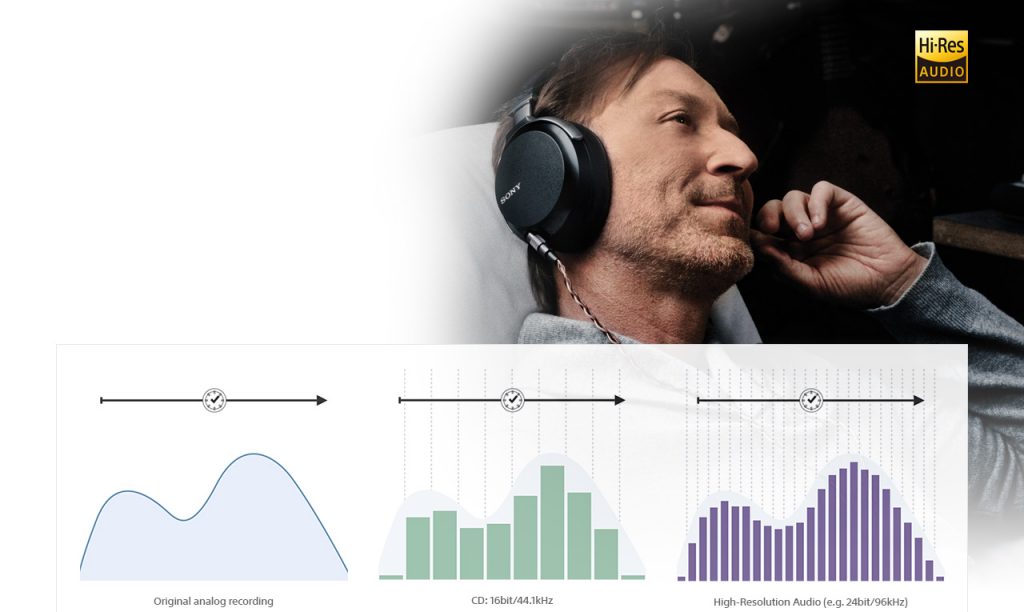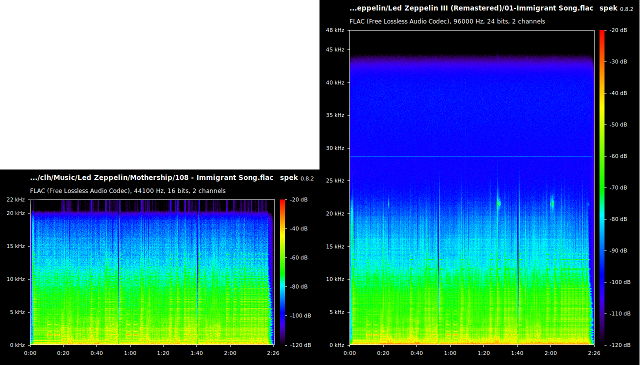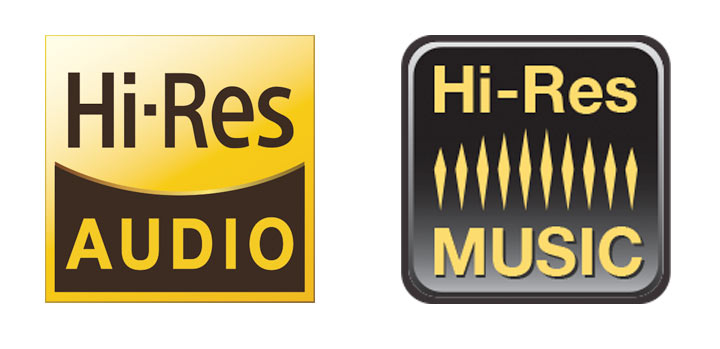What is Digital Audio?
Music or sounds in general can be viewed as waves. In nature and from vinyl records and tapes the wave is analog or a smooth representation of the sound. In theory humans can hear between 20Hz and 20kHz frequencies, but as we age the high end frequencies get lower and after 26 years old we really only hear to 15kHz. Also in theory in order to accurately sample to 20kHz it is necessary to sample at around 40kHz. To understand why this is true read this article on the Nyquist-Shannon sampling theorem.
Let’s drop back first and describe CD audio or standard quality. CD audio is described by the Red Book standard established by Sony and Philips in 1980. The standard is based on Pulse Code Modulated (PCM) storage which is a means of storing the amplitude of a signal at any given time. See the picture below to see how an analog waveform compares to a PCM waveform in both the CD and Hi-Res formats. The Red Book standard states that sampling should be 44.1 kHz. Based on the Nyquist-Shannon theorem this is sufficient to capture all the audio that humans can hear.

Looking at the diagram above, the PCM waves look jagged, but they are passed through a smoothing filter before they are sent to the DAC (Digital to Analog Converter). The result coming out of the speaker will be a wave that is smoothed to be as close to the original as is possible with the data provided. I phrase it that way for a reason which I will explain further later in the article.
Digital audio is specified by the sampling rate and the bit density. So, CDs are 44.1kHz 16 bit usually written as 44.1kHz/16. The bit density determines the height of the bars in the picture which corresponds to the volume. The 16 bit resolution or depth used for CDs allows for a dynamic range (the difference between the loudest and softest notes) of around 96 decibels. That is sufficient to capture most live music.
Compressed Formats
In order to save storage space or to be able to stream over low bandwidth internet connections compressed formats are used. There are both lossless (where all the data are preserved) and lossy formats. Let’s dig into lossy compression first.
In the early days of streaming MP3 gained popularity due to the small file sizes that can be achieved. It is a really great format for reducing the size of a file, but at the expense of the audio quality. MP3 files quality is measured in bit rates. The highest quality and largest file sizes are achieved with 320 kilobits per second (kbps). Sampling frequencies can also be specified, but for the highest quality 44.1 kHz or 48 kHz is used.
MP3 files achieve small sizes by passing the data through a psychoacoustic filter that removes some data which is considered inaudible. Higher bit rates are generally very good at reproducing music and some people find them indistinguishable from CD. However, the lossy format always removes some data and it is possible for other people to determine that the music has experienced lossy compression even at the highest quality.
There are other lossy formats, but they all employ the same strategy to reduce the file sizes. Lossless compression is used to save space, but not lose any data. It can even be used for Hi-Res audio. FLAC (Free Lossless Audio Codec) is widely used for Hi-Res and CD quality audio without any detrimental effects.
Finally, Hi-Res
Simply Hi-Res audio is audio recorded at a higher sampling rate and bit rate than CD. Anything higher than 48kHz/16 bit would be considered Hi-Res. Hi-Res music is often stored in FLAC to save space. It can also come in uncompressed formats like WAV up to 192kHz/24. Direct Stream Digital (DSD) is used for SACD files and is not PCM. It is Hi-Res, but a completely different format that results in very large files. To understand DSD better read here.
Let me stop for a moment and talk about the logos at the top of the article. Hi-Res Audio and the logo were introduced by Sony. The logo now applied to anything that can work with higher bit rates. That includes audio equipment such as recievers, music servers like Roon or streaming services like Tidal.
Hi-Res Music was introduced by The Producers & Engineers Wing of The Recording Academy. They have also developed a set of production guidelines for high-resolution music. They use of the logo indicates the music has been produced using these guidelines and should be of the highest possible production quality.
This implies you need special equipment to enjoy Hi-Res Music and indeed you do, but not too special. Most new car audio is capable of decoding and reproducing Hi-Res Music. You can stream Hi-Res from Tidal or Qobuz in most countries and many smartphones can decode it. If you listen over bluetooth you will need to support the aptX codec in order to be Hi-Res.
But Do I Really Care?
Maybe and maybe not. Here’s the thing – the CD standard was developed with sufficient frequency response and dynamic range to reproduce music and I think most people would agree that CDs sound pretty good. Some people are perfectly happy with MP3. But, some people can hear the difference between a vinyl record and a CD. There definitely are higher frequencies in music than are provided by a CD. You can see the differences in the spectragraph below.

The OpenSource article that had these images also references a study done that shows people can tell the difference between Hi-Res and CD quality audio. I think I am one of them. To me Hi-Res audio is less fatiguing to listen to. It is airier and the high frequencies aren’t as harsh. For me it is worth the trouble, so I make sure all my equipment is capable of reproducing the music faithfully.
That is not to say I have spent a fortune. I picked Bluesound speakers for their ability to play Hi-Res music. I want the DAC to be able to reproduce the closest approximation to live as is possible. Sonos can only play CD quality music, but they have done such a great job with their speakers the sound is really good. There is not much price difference between Bluesound and Sonos and for a freestanding speaker the ability to play Hi-Res might not be that important for most people.
However, for serious listening I think it does matter. I use a Canton speaker setup with a Denon receiver. The whole setup was under $1000. I have my PC connected to the receiver with an HDMI cable. Most of the time I use the DAC built into the receiver and feed it 192kHz/24 bit audio. I have a few recordings in both CD and Hi-Res and one of them is Landslide by Fleetwood Mac. The acoustic guitar and Stevie Nicks’ voice both sound better and clearer in Hi-Res. I use it for A-B comparisons for friends and some of them can hear the difference too.
Final Words
So, what is going on, why can some people hear a difference? If the CD standard can reproduce all the frequencies we can hear then why would there be a difference? There is some evidence that higher frequencies do have an impact. See this article about hypersonic frequencies.
But, I have always thought, without any scientific evidence, that it really comes down to producing a more accurate waveform. I want to go back to what I said earlier about the DAC reproducing as well as it can with the data provided. If you provide it more data then the smoothing filter isn’t as necessary or doesn’t have to smooth as much. In reality a higher sampling rate makes it easier for the DAC to reproduce the waveform as it was when it was first recorded. There continues to be a question of whether people can really hear the difference, but that is ultimately up to you. The resurgence of vinyl seems to indicate at least some people think the closer to analog the better. I agree.
